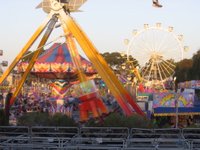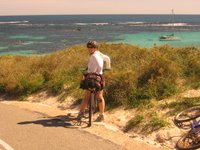Perth Royal Show
 At the beginning of Oct. was the Perth Royal Show, a big deal in these parts; the pics give an idea of why! The show coincides with when the kids start their 2-week spring school holidays, so it's high on the list of things to do to keep the family entertained. It reminded me a bit of the Brandon Fair, and what the Red River Ex used to be like.
At the beginning of Oct. was the Perth Royal Show, a big deal in these parts; the pics give an idea of why! The show coincides with when the kids start their 2-week spring school holidays, so it's high on the list of things to do to keep the family entertained. It reminded me a bit of the Brandon Fair, and what the Red River Ex used to be like.  Greg took a good look at all the new fangled rides, and still concluded matter-of-factly, that the "zipper" at the Morris Stampede continues to be the ride of all time (what with it's bolts shearing off, badass carny operating the thing, and overall fear factor)
Greg took a good look at all the new fangled rides, and still concluded matter-of-factly, that the "zipper" at the Morris Stampede continues to be the ride of all time (what with it's bolts shearing off, badass carny operating the thing, and overall fear factor)Some history, taken from one of the Show's websites:
 'The Royal Agricultural Society of Western Australia, established 1831, has held the annual show at the Claremont grounds since 1894. The Show has been named an icon of Western Australia. The primary purpose of the Show was to showcase Western Australia industry, primarily agriculture. It has been the venue for the display of new animal breeds and sports. The first show included equestrian events, sheep dog trials, wood chopping, and prizes for cattle and sheep.' We watched these guys shear the sheep with actual scissors, old school style.
'The Royal Agricultural Society of Western Australia, established 1831, has held the annual show at the Claremont grounds since 1894. The Show has been named an icon of Western Australia. The primary purpose of the Show was to showcase Western Australia industry, primarily agriculture. It has been the venue for the display of new animal breeds and sports. The first show included equestrian events, sheep dog trials, wood chopping, and prizes for cattle and sheep.' We watched these guys shear the sheep with actual scissors, old school style. There was also some Canadian influence here: the augers in this pic were made by WheatHeart in Saskatoon, a division of the company that also owns Westfield, and the shafts were actually manufactured in little ol' Rosenort. Pretty small world, eh?!
There was also some Canadian influence here: the augers in this pic were made by WheatHeart in Saskatoon, a division of the company that also owns Westfield, and the shafts were actually manufactured in little ol' Rosenort. Pretty small world, eh?!I have to mention the showbags, because I've never seen such outrageous commercialism so easily eaten up! 'The 'showbag', which became part of Australian shows as an advertising gimmick and souvenir, are now sold at $2 to $65 each and contain a variety of cheap novelty toys, candy, and even complete skateboards. Showbags are sponsored by a specific candy company, television show, brand name (e.g. Coca-Cola)', or even FHM or lingerie for adults. They are a focal point of the Show for EVERYONE! We bought a $6 Cadbury bag, and had enough choc to last 3 weeks. It's like Hallowe'en, except you have to pay for it! I was shocked to see parents hauling around up to 10 bags in each hand, ensuring that the kids will be wired (and diabetic) in short time.
 The only ride I dared to go on was the ferris wheel. Greg is getting increasingly frustrated with our Canan A510 camera, which is only a year old, and is now starting to "wash" out all of our photos. Seems to be a similar pattern given what happened to Jer's camera.
The only ride I dared to go on was the ferris wheel. Greg is getting increasingly frustrated with our Canan A510 camera, which is only a year old, and is now starting to "wash" out all of our photos. Seems to be a similar pattern given what happened to Jer's camera. Left - Me and the mini-belly in front of the rides.
Left - Me and the mini-belly in front of the rides.Our highlight of the show was the sheep-dog exhibit. Fascinating to watch the dogs round up all those sheep so efficiently. In one exhibit, the judge replaced the sheep with ducks, to see how the dog would react. Turned out to be hilarious, cause the dog would make an attempt to move the ducks, but would constantly stop, look back at the sheep, and then desparately at his owner, wondering what in the world was going on, but longing to please.




















